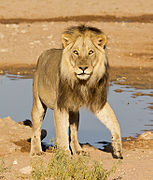|
El león africano del sur[1][2] (Panthera leo vernayi) es una subespecie de león en el sur de África.[3] En esta parte de África, los leones se encuentran en Angola, Botsuana, la República Democrática del Congo, Malaui, Mozambique, Namibia (incluyendo el Kalahari),[4] Sudáfrica, Suazilandia, Zambia y Zimbabue, pero se han extinguido regionalmente en Lesoto.[5] Las poblaciones de leones en áreas protegidas gestionadas intensivamente en Botsuana, Namibia, Sudáfrica y Zimbabue han aumentado desde el cambio de siglo.[6]
El espécimen tipo para P. l. melanochaita era un león de melena negra del Cabo de Buena Esperanza, conocido como el león del Cabo. La población de leones en esta parte de Sudáfrica está extinta.[7] Las poblaciones de leones vivos en otras partes del sur de África fueron mencionadas por varios nombres, como el león de Transvaal (Panthera leo krugeri), león de Katanga (Panthera leo bleyenberghi), león de Kalahari (Panthera leo vernayi),[8][9][10] león del sudoeste africano,[11] y el león sudafricano.[12][13]
El león africano del sur se ha descrito como la subespecie viva más grande del león en África.[14][15][16]
Galería
Véase también
Referencias
- ↑ a b Yamaguchi, N. (2000). «The Barbary lion and the Cape lion: their phylogenetic places and conservation». African Lion Working Group News 1: 9-11. Archivado desde el original el 4 de marzo de 2016. Consultado el 16 de abril de 2018.
- ↑ a b Barnett, R.; Yamaguchi, N.; Barnes, I.; Cooper, A. (2006). «Lost populations and preserving genetic diversity in the lion Panthera leo: Implications for its ex situ conservation». Conservation Genetics 7 (4): 507-514. doi:10.1007/s10592-005-9062-0. Archivado desde el original el 24 de agosto de 2006.
- ↑ a b Kitchener, A. C.; Breitenmoser-Würsten, C.; Eizirik, E.; Gentry, A.; Werdelin, L.; Wilting, A.; Yamaguchi, N.; Abramov, A. V.; Christiansen, P.; Driscoll, C.; Duckworth, J. W.; Johnson, W.; Luo, S.-J.; Meijaard, E.; O’Donoghue, P.; Sanderson, J.; Seymour, K.; Bruford, M.; Groves, C.; Hoffmann, M.; Nowell, K.; Timmons, Z.; Tobe, S. (2017). «A revised taxonomy of the Felidae: The final report of the Cat Classification Task Force of the IUCN Cat Specialist Group». Cat News (Special Issue 11).
- ↑ Geptner, V. G., Sludskij, A. A. (1972). Mlekopitajuščie Sovetskogo Soiuza. Vysšaia Škola, Moskva. (In Russian; English translation: Heptner, V.G., Sludskii, A. A., Komarov, A., Komorov, N.; Hoffmann, R. S. (1992). Mammals of the Soviet Union. Vol III: Carnivores (Feloidea). Smithsonian Institution and the National Science Foundation, Washington DC).
- ↑ Bauer, H.; Packer, C.; Funston, P. F.; Henschel, P.; Nowell, K. (2016). «Panthera leo». The IUCN Red List of Threatened Species (IUCN) 2016: e.T15951A115130419. doi:10.2305/IUCN.UK.2016-3.RLTS.T15951A107265605.en. Consultado el 15 de enero de 2018.
- ↑ Bauer, H., Chapron, G., Nowell, K., Henschel, P., Funston, P., Hunter, L.T., Macdonald, D.W. and Packer, C. (2015). «Lion (Panthera leo) populations are declining rapidly across Africa, except in intensively managed areas». Proceedings of the National Academy of Sciences 112 (48): 14894-14899.
- ↑ Mazak, V. (1975). «Notes on the Black-maned Lion of the Cape, Panthera leo melanochaita (Ch. H. Smith, 1842) and a Revised List of the Preserved Specimens». Verhandelingen Koninklijke Nederlandse Akademie van Wetenschappen (64): 1-44.
- ↑ Lönnberg, E. (1914). «New and rare mammals from Congo». Revue de Zoologie Africaine (3): 273-278.
- ↑ Roberts, A. (1929). «New forms of African mammals». Annals of the Transvaal Museum 21 (13): 82-121.
- ↑ Roberts, A. (1948). «Descriptions of some new subspecies of mammals». Annals of the Transvaal Museum 21 (1): 63-69.
- ↑ Jackson, Deirdre (12 de mayo de 2010). «Introduction». Lion. London: Reaktion Books. pp. 1-21. ISBN 1861897359.
- ↑ Selous, Frederick Courtney (19 de mayo de 2011). «XXV». Travel and Adventure in South-East Africa. New York: Cambridge University Press. p. 445. ISBN 1108031161.
- ↑ Schofield, A. (2013). White Lion: Back to the Wild. Pennsauken: BookBaby. ISBN 0620570059.
- ↑ Smuts, G.L.; Robinson, G.A.; Whyte, I.J. (1980). «Comparative growth of wild male and female lions (Panthera leo)». Journal of Zoology 190 (3): 365-373. doi:10.1111/j.1469-7998.1980.tb01433.x.
- ↑ Wood, G. L. (1983). The Guinness Book of Animal Facts and Feats. Sterling Pub Co Inc ISBN 978-0-85112-235-9
- ↑ Brakefield, T. (1993). Big Cats: Kingdom of Might. Voyageur Press. p. 44. ISBN 978-0-89658-329-0.
|



